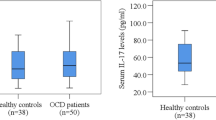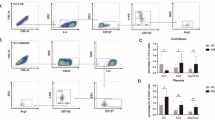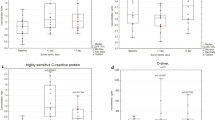Abstract
Human milk contains large amounts of free oligosaccharides (HMOs). HMOs have been shown to exert antiinflammatory properties, and evidence for their immunomodulatory effects is increasing. The purpose of this study was to evaluate influences of two human breast milk–derived oligosaccharide samples (neutral and acidic oligosaccharides), and of a low-molecular-weight fucoidan on cytokine production and activation of cord blood mononuclear cells. Cord blood mononuclear cells from randomly chosen healthy newborns were co-cultured with the oligosaccharide samples. By means of flow cytometry, intracellular cytokine production (d 20) and surface marker expression of T cells (d 5) were measured. In vitro–induced Ig levels were quantified nephelometrically (total IgG1) and by ELISA (total IgE) in the supernatant of cell cultures. The acidic oligosaccharide fraction increased the percentage of interferon-γ producing CD3+CD4+ and CD3+CD8+ cells (p < 0.05) and the IL-13 production in CD3+CD8+ cells (p < 0.05). In acidic oligosaccharide cultures, CD25+ expression on CD3+CD4+ cells was significantly elevated (p < 0.05). Low-molecular-weight fucoidan induced IL-4 production in CD3+CD4+ T cells (p < 0.05) and IL-13 production in CD3+CD8+ T cells (p < 0.05), whereas interferon-γ production remained unaffected in both T-cell populations. Ig production (total IgE and total IgG1) remained unaffected. Human milk–derived oligosaccharides and plant-derived oligosaccharides affect the cytokine production and activation of cord blood derived T cells in vitro. Therefore, oligosaccharides and, in particular, acidic oligosaccharides may influence lymphocyte maturation in breast-fed newborns.
Similar content being viewed by others
Log in or create a free account to read this content
Gain free access to this article, as well as selected content from this journal and more on nature.com
or
Abbreviations
- aHMOs:
-
acidic oligosaccharides
- CBMC:
-
cord blood mononuclear cells
- HMOs:
-
human milk oligosaccharides
- LMWF:
-
low-molecular-weight fucoidan
- nHMOs:
-
neutral oligosaccharides
- PHA:
-
phytohemagglutinin
- PMA:
-
phorbol myristate acetate
References
Holt PG, Jones CA 2000 The development of the immune system during pregnancy and early life. Allergy 55: 688–697
Prescott SL, Macaubas C, Smallacombe T, Holt BJ, Sly PD, Holt PG 1999 Development of allergen-specific T-cell memory in atopic and normal children. Lancet 353: 196–200
Coppa GV, Pierani P, Zampini L, Carloni I, Carlucci A, Gabrielli O 1999 Oligosaccharides in human milk during different phases of lactation. Acta Paediatr Suppl 88: 89–94
Engfer MB, Stahl B, Finke B, Sawatzki G, Daniel H 2000 Human milk oligosaccharides are resistant to enzymatic hydrolysis in the upper gastrointestinal tract. Am J Clin Nutr 71: 1589–1596
Gnoth MJ, Kunz C, Kinne-Saffran E, Rudloff S 2000 Human milk oligosaccharides are minimally digested in vitro. J Nutr 130: 3014–3020
Kunz C, Rudloff S, Baier W, Klein N, Strobel S 2000 Oligosaccharides in human milk: structural, functional, and metabolic aspects. Annu Rev Nutr 20: 699–722
Newburg DS 2001 Bioactive components of human milk: evolution, efficiency, and protection. Adv Exp Med Biol 501: 3–10
Velupillai P, Harn DA 1994 Oligosaccharide-specific induction of interleukin 10 production by B220+ cells from schistosome-infected mice: a mechanism for regulation of CD4+ T-cell subsets. Proc Natl Acad Sci U S A 91: 18–22
Terrazas LI, Walsh KL, Piskorska D, McGuire E, Harn DA 2001 The schistosome oligosaccharide lacto-N-neotetraose expands Gr1(+) cells that secrete anti-inflammatory cytokines and inhibit proliferation of naive CD4(+) cells: a potential mechanism for immune polarization in helminth infections. J Immunol 167: 5294–5303
Rudloff S, Stefan C, Pohlentz G, Kunz C 2002 Detection of ligands for selectins in the oligosaccharide fraction of human milk. Eur J Nutr 41: 85–92
Obermeier S, Rudloff S, Pohlentz G, Lentze MJ, Kunz C 1999 Secretion of 13C-labelled oligosaccharides into human milk and infant's urine after an oral [13C]galactose load. Isotopes Environ Health Stud 35: 119–125
Gnoth MJ, Rudloff S, Kunz C, Kinne RK 2001 Investigations of the in vitro transport of human milk oligosaccharides by a Caco-2 monolayer using a novel high performance liquid chromatography-mass spectrometry technique. J Biol Chem 276: 34363–34370
Kobata A 1973 [Biochemical basis for blood groups]. Tanpakushitsu Kakusan Koso 18: 83–92
Finke B 2000 Isolierung und Charakterisierung von Oligosacchariden aus humanen und tierischen Milchen. Shaker Verlag, Aachen, Germany
Thurl S, Muller-Werner B, Sawatzki G 1996 Quantification of individual oligosaccharide compounds from human milk using high-pH anion-exchange chromatography. Anal Biochem 235: 202–206
Finke B, Mank M, Daniel H, Stahl B 2000 Offline coupling of low-pressure anion-exchange chromatography with MALDI-MS to determine the elution order of human milk oligosaccharides. Anal Biochem 284: 256–265
Deux JF, Meddahi-Pelle A, Le Blanche AF, Feldman LJ, Colliec-Jouault S, Bree F, Boudghene F, Michel JB, Letourneur D 2002 Low molecular weight fucoidan prevents neointimal hyperplasia in rabbit iliac artery in-stent restenosis model. Arterioscler Thromb Vasc Biol 22: 1604–1609
Pfenninger A, Karas M, Finke B, Stahl B, Sawatzki G 1999 Matrix optimization for matrix-assisted laser desorption/ionization mass spectrometry of oligosaccharides from human milk. J Mass Spectrom 34: 98–104
Papac DI, Wong A, Jones AJ 1996 Analysis of acidic oligosaccharides and glycopeptides by matrix-assisted laser desorption/ionization time-of-flight mass spectrometry. Anal Chem 68: 3215–3223
Gnoth MJ, Kunz C, Rudloff S 2000 Endotoxin-reduced milk oligosaccharide fractions suitable for cell biological studies. Eur J Med Res 5: 468–472
Szepfalusi Z, Nentwich I, Gerstmayr M, Jost E, Todoran L, Gratzl R, Herkner K, Urbanek R 1997 Prenatal allergen contact with milk proteins. Clin Exp Allergy 27: 28–35
Kopp MV, Pichler J, Halmerbauer G, Kuehr J, Frischer T, Urbanek R, Szepfalusi Z 2000 Culture conditions for the detection of allergen-specific T-cell reactivity in cord blood: influence of cell number. Pediatr Allergy Immunol 11: 4–11
Bode L, Rudloff S 2001 Mögliche systemische Effekte von Humanmilch-oligosacchariden (Hmo)—ein in vitro Modell. Monatsschr Kinderheilkd 149: 149–1132
Rudloff S, Pohlentz G, Diekmann L, Egge H, Kunz C 1996 Urinary excretion of lactose and oligosaccharides in preterm infants fed human milk or infant formula. Acta Paediatr 85: 598–603
Miles EA, Warner JA, Lane AC, Jones AC, Colwell BM, Warner Jo 1994 Altered T lymphocyte phenotype at birth in babies born to atopic parents. Pediatr Allergy Immunol 5: 202–208
Pichler J, Gerstmayr M, Szepfalusi Z, Urbanek R, Peterlik M, Willheim M 2002 1 alpha,25(OH)2D3 inhibits not only Th1 but also Th2 differentiation in human cord blood T cells. Pediatr Res 52: 12–18
Viemann D, Schlenke P, Hammers HJ, Kirchner H, Kruse A 2000 Differential expression of the B cell-restricted molecule CD22 on neonatal B lymphocytes depending upon antigen stimulation. Eur J Immunol 30: 550–559
Gehring S, Schlaak M, van der Bosch J 1998 A new in vitro model for studying human T cell differentiation: T(h1)/T(h2) induction following activation by superantigens. J Immunol Methods 219: 85–98
Jung T, Schauer U, Heusser C, Neumann C, Rieger C 1993 Detection of intracellular cytokines by flow cytometry. J Immunol Methods 159: 197–207
Prussin C, Metcalfe DD 1995 Detection of intracytoplasmic cytokine using flow cytometry and directly conjugated anti-cytokine antibodies. J Immunol Methods 188: 117–128
Coppa GV, Gabrielli O, Giorgi P, Catassi C, Montanari MP, Varaldo PE, Nichols BL 1990 Preliminary study of breastfeeding and bacterial adhesion to uroepithelial cells. Lancet 335: 569–571
Newburg DS 1999 Human milk glycoconjugates that inhibit pathogens. Curr Med Chem 6: 117–127
Klein N, Schwertmann A, Peters M, Kunz C, Strobel S 2000 Immunomodulatory effects of breast milk oligosaccharides. Adv Exp Med Biol 478: 251–259
Kondo N, Kobayashi Y, Shinoda S, Takenaka R, Teramoto T, Kaneko H, Fukao T, Matsui E, Kasahara K, Yokoyama Y 1998 Reduced interferon gamma production by antigen-stimulated cord blood mononuclear cells is a risk factor of allergic disorders 6-year follow- up study. Clin Exp Allergy 28: 1340–1344
Prescott SL, Macaubas C, Smallacombe T, Holt BJ, Sly PD, Loh R, Holt PG 1998 Reciprocal age-related patterns of allergen-specific T-cell immunity in normal vs. atopic infants. Clin Exp Allergy 28: ( suppl 5) 39–44
Williams TJ, Jones CA, Miles EA, Warner JO, Warner JA 2000 Fetal and neonatal IL-13 production during pregnancy and at birth and subsequent development of atopic symptoms. J Allergy Clin Immunol 105: 951–959
Pastorelli G, Rousset F, Pene J, Peronne C, Roncarolo MG, Tovo PA, de Vries JE 1990 Cord blood B cells are mature in their capacity to switch to IgE- producing cells in response to interleukin-4 in vitro. Clin Exp Immunol 82: 114–119
Author information
Authors and Affiliations
Corresponding author
Additional information
Supported by the BMBF-Fonds 0311827 A/B/C and the FWF-grant (P1465-PAT).
Rights and permissions
About this article
Cite this article
Eiwegger, T., Stahl, B., Schmitt, J. et al. Human Milk–Derived Oligosaccharides and Plant-Derived Oligosaccharides Stimulate Cytokine Production of Cord Blood T-Cells In Vitro. Pediatr Res 56, 536–540 (2004). https://doi.org/10.1203/01.PDR.0000139411.35619.B4
Received:
Accepted:
Issue date:
DOI: https://doi.org/10.1203/01.PDR.0000139411.35619.B4
This article is cited by
-
Potential biological functions and future perspectives of sialylated milk oligosaccharides
Archives of Pharmacal Research (2024)
-
Metabolic engineering of Bacillus subtilis for de novo synthesis of 6′-sialyllactose
Systems Microbiology and Biomanufacturing (2024)
-
Associations between human milk oligosaccharides and infant growth in a Bangladeshi mother–infant cohort
Pediatric Research (2023)
-
Profiling of aminoxyTMT-labeled bovine milk oligosaccharides reveals substantial variation in oligosaccharide abundance between dairy cattle breeds
Scientific Reports (2019)
-
Fucosylated oligosaccharides in mother’s milk alleviate the effects of caesarean birth on infant gut microbiota
Scientific Reports (2018)



